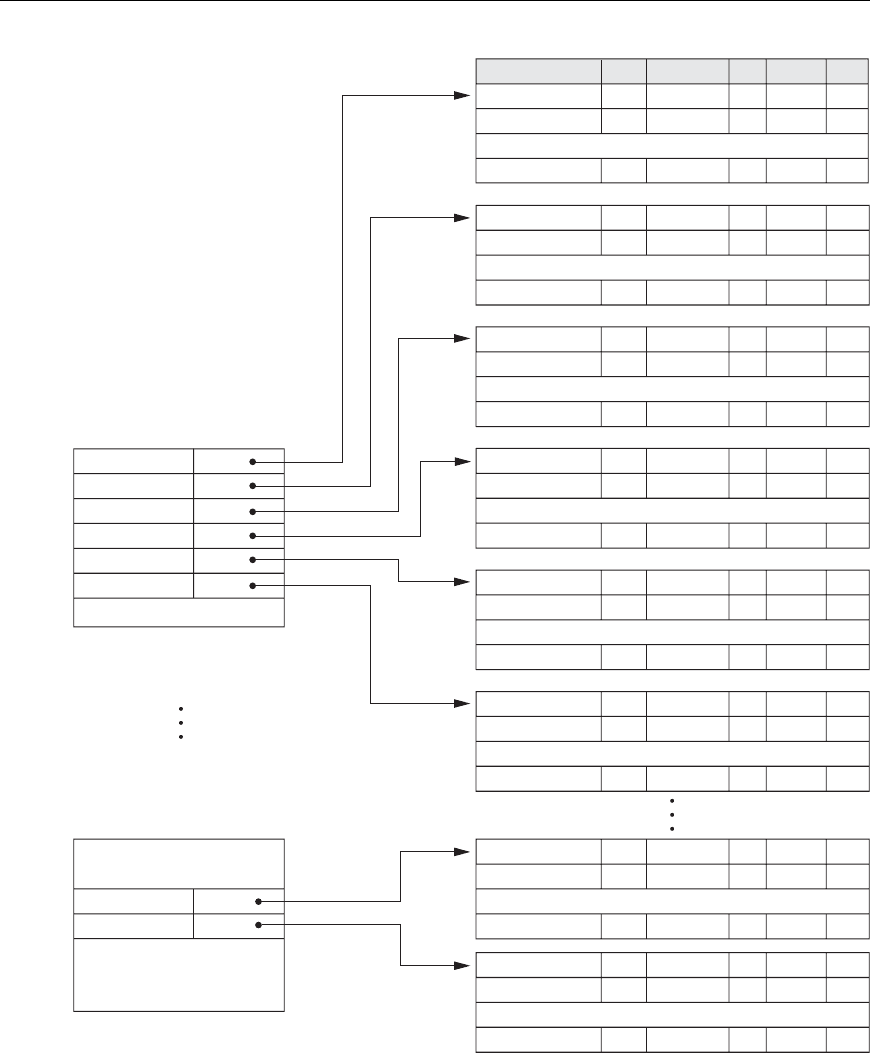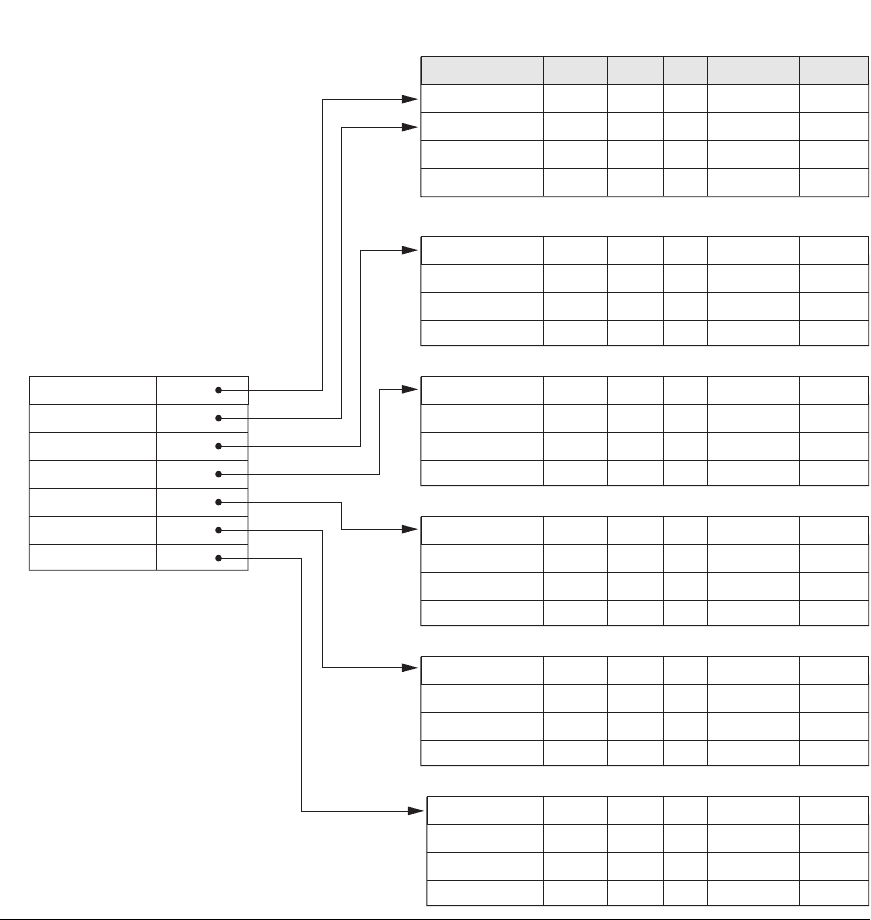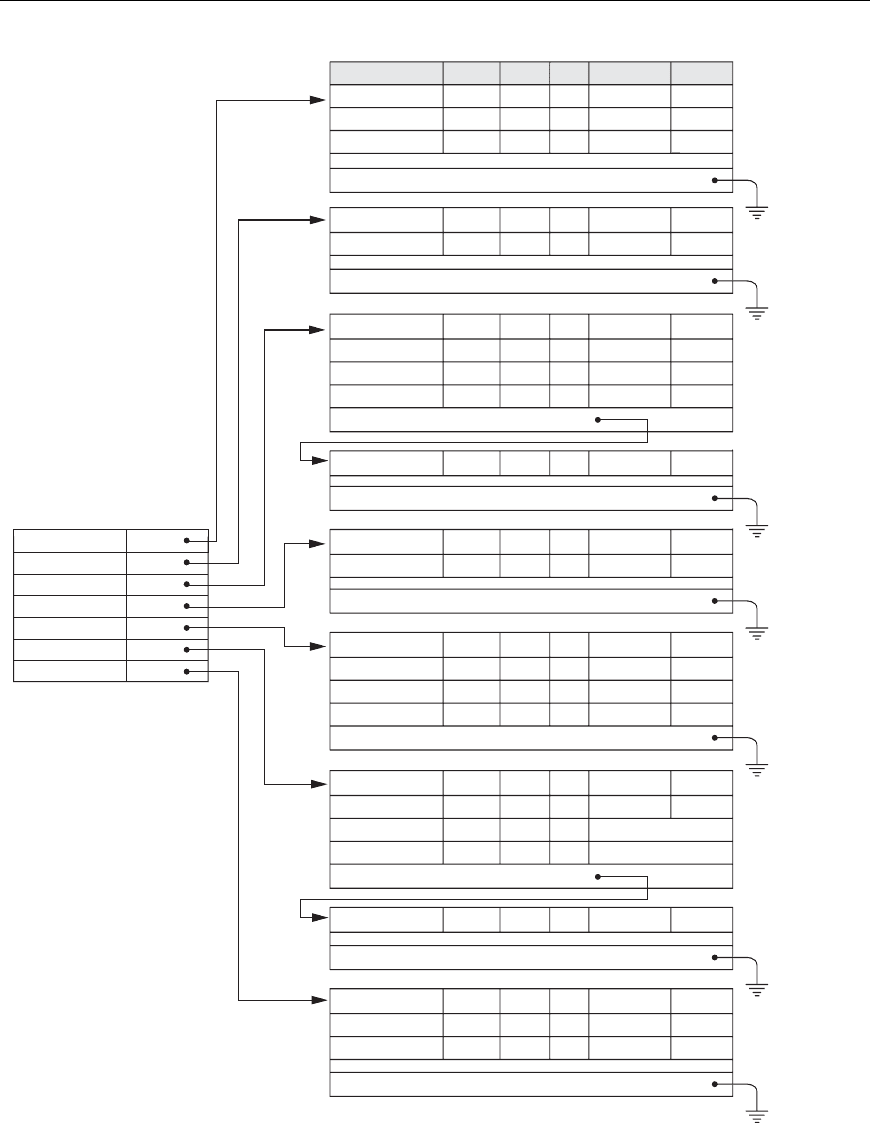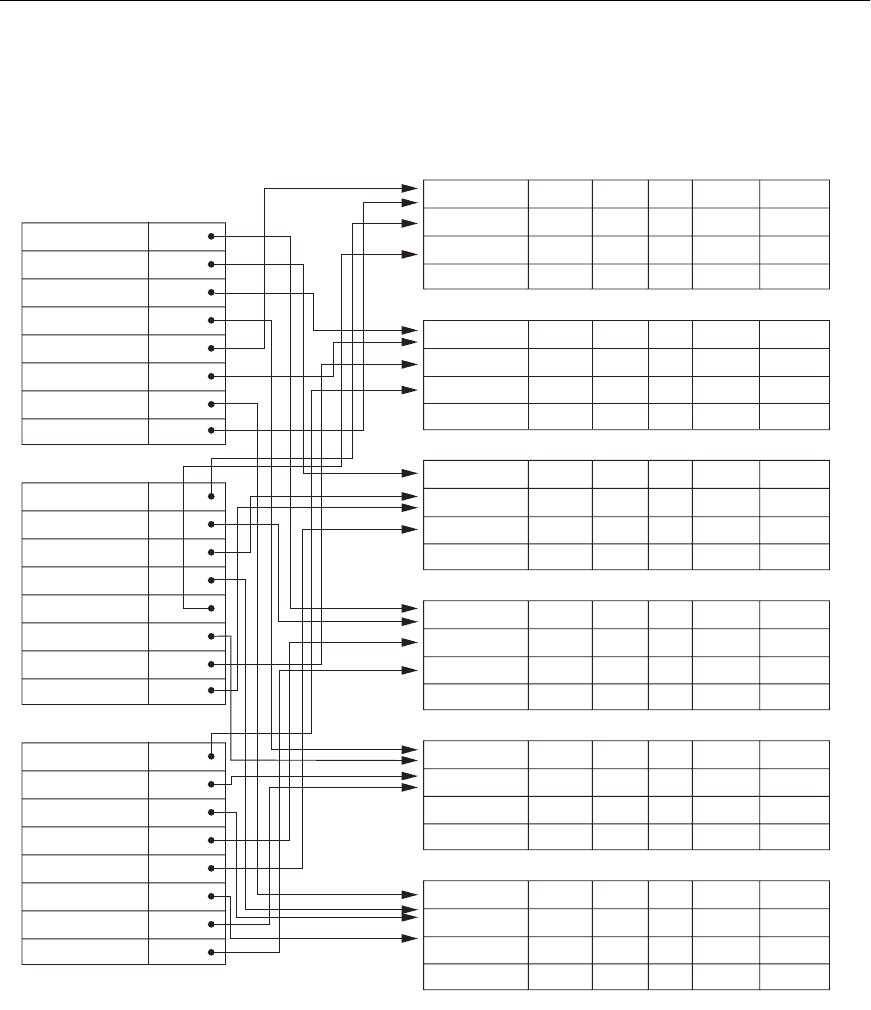Elmasri R., Navathe S.B. Fundamentals of Database Systems
Подождите немного. Документ загружается.


632 Chapter 18 Indexing Structures for Files
generating indexes on demand in most relational DBMSs. Section 18.4 is devoted to
alternative ways to access data based on a combination of multiple keys. In Section
18.5 we discuss hash indexes and introduce the concept of logical indexes, which
give an additional level of indirection from physical indexes, allowing for the physi-
cal index to be flexible and extensible in its organization. In Section 18.6 we discuss
multikey indexing and bitmap indexes used for searching on one or more keys.
Section 18.7 summarizes the chapter.
18.1 Types of Single-Level Ordered Indexes
The idea behind an ordered index is similar to that behind the index used in a text-
book, which lists important terms at the end of the book in alphabetical order along
with a list of page numbers where the term appears in the book. We can search the
book index for a certain term in the textbook to find a list of addresses—page num-
bers in this case—and use these addresses to locate the specified pages first and then
search for the term on each specified page. The alternative, if no other guidance is
given, would be to sift slowly through the whole textbook word by word to find the
term we are interested in; this corresponds to doing a linear search, which scans the
whole file. Of course, most books do have additional information, such as chapter
and section titles, which help us find a term without having to search through the
whole book. However, the index is the only exact indication of the pages where each
term occurs in the book.
For a file with a given record structure consisting of several fields (or attributes), an
index access structure is usually defined on a single field of a file, called an indexing
field (or indexing attribute).
1
The index typically stores each value of the index
field along with a list of pointers to all disk blocks that contain records with that
field value. The values in the index are ordered so that we can do a binary search on
the index. If both the data file and the index file are ordered, and since the index file
is typically much smaller than the data file, searching the index using a binary
search is a better option. Tree-structured multilevel indexes (see Section 18.2)
implement an extension of the binary search idea that reduces the search space by 2-
way partitioning at each search step, thereby creating a more efficient approach that
divides the search space in the file n-ways at each stage.
There are several types of ordered indexes. A primary index is specified on the
ordering key field of an ordered file of records. Recall from Section 17.7 that an
ordering key field is used to physically order the file records on disk, and every record
has a unique value for that field. If the ordering field is not a key field—that is, if
numerous records in the file can have the same value for the ordering field—
another type of index, called a clustering index, can be used. The data file is called a
clustered file in this latter case. Notice that a file can have at most one physical
ordering field, so it can have at most one primary index or one clustering index, but
not both. A third type of index, called a secondary index, can be specified on any
1
We use the terms field and attribute interchangeably in this chapter.

18.1 Types of Single-Level Ordered Indexes 633
nonordering field of a file. A data file can have several secondary indexes in addition
to its primary access method. We discuss these types of single-level indexes in the
next three subsections.
18.1.1Primary Indexes
A primary index is an ordered file whose records are of fixed length with two fields,
and it acts like an access structure to efficiently search for and access the data
records in a data file. The first field is of the same data type as the ordering key
field—called the primary key—of the data file, and the second field is a pointer to a
disk block (a block address). There is one index entry (or index record) in the
index file for each block in the data file. Each index entry has the value of the pri-
mary key field for the first record in a block and a pointer to that block as its two
field values. We will refer to the two field values of index entry i as <K(i), P(i)>.
To create a primary index on the ordered file shown in Figure 17.7, we use the
Name
field as primary key, because that is the ordering key field of the file (assuming that
each value of
Name is unique). Each entry in the index has a Name value and a
pointer. The first three index entries are as follows:
<K(1) = (Aaron, Ed), P(1) = address of block 1>
<K(2) = (Adams, John), P(2) = address of block 2>
<K(3) = (Alexander, Ed), P(3) = address of block 3>
Figure 18.1 illustrates this primary index. The total number of entries in the index is
the same as the number of disk blocks in the ordered data file. The first record in each
block of the data file is called the anchor record of the block, or simply the block
anchor.
2
Indexes can also be characterized as dense or sparse. A dense index has an index
entry for every search key value (and hence every record) in the data file. A sparse
(or nondense) index, on the other hand, has index entries for only some of the
search values. A sparse index has fewer entries than the number of records in the
file. Thus, a primary index is a nondense (sparse) index, since it includes an entry
for each disk block of the data file and the keys of its anchor record rather than for
every search value (or every record).
The index file for a primary index occupies a much smaller space than does the data
file, for two reasons. First, there are fewer index entries than there are records in the
data file. Second, each index entry is typically smaller in size than a data record
because it has only two fields; consequently, more index entries than data records
can fit in one block. Therefore, a binary search on the index file requires fewer block
accesses than a binary search on the data file. Referring to Table 17.2, note that the
binary search for an ordered data file required log
2
b block accesses. But if the pri-
mary index file contains only b
i
blocks, then to locate a record with a search key
2
We can use a scheme similar to the one described here, with the last record in each block (rather than
the first) as the block anchor. This slightly improves the efficiency of the search algorithm.

634 Chapter 18 Indexing Structures for Files
Index file
(<K(i), P(i)> entries)
Block anchor
primary key
value
Block
pointer
(Primary
key field)
Name
Aaron, Ed
Abbot, Diane
.
.
.
.
.
.
.
.
.
.
.
.
.
.
.
Acosta, Marc
Adams, John
Adams, Robin
Akers, Jan
Alexander, Ed
Alfred, Bob
Allen, Sam
Allen, Troy
Anders, Keith
Anderson, Rob
Anderson, Zach
Angel, Joe
Archer, Sue
Arnold, Mack
Arnold, Steven
Atkins, Timothy
Wong, James
Wood, Donald
Woods, Manny
Wright, Pam
Wyatt, Charles
Zimmer, Byron
Aaron, Ed
Adams, John
Alexander, Ed
Allen, Troy
Anderson, Zach
Arnold, Mack
Wong, James
Wright, Pam
.
.
.
.
.
.
.
.
.
. . .. . .
Ssn Birth_date Job
Salary
Sex
Figure 18.1
Primary index on the ordering key field of
the file shown in Figure 17.7.

18.1 Types of Single-Level Ordered Indexes 635
value requires a binary search of that index and access to the block containing that
record: a total of log
2
b
i
+ 1 accesses.
A record whose primary key value is K lies in the block whose address is P(i), where
K(i) ≤ K < K(i + 1). The ith block in the data file contains all such records because
of the physical ordering of the file records on the primary key field. To retrieve a
record, given the value K of its primary key field, we do a binary search on the index
file to find the appropriate index entry i, and then retrieve the data file block whose
address is P(i).
3
Example 1 illustrates the saving in block accesses that is attainable
when a primary index is used to search for a record.
Example 1. Suppose that we have an ordered file with r = 30,000 records stored on
a disk with block size B = 1024 bytes. File records are of fixed size and are
unspanned, with record length R = 100 bytes. The blocking factor for the file would
be bfr = ⎣(B/R)⎦ = ⎣(1024/100)⎦ = 10 records per block. The number of blocks
needed for the file is b = ⎡(r/bfr)⎤ = ⎡(30000/10)⎤ = 3000 blocks. A binary search on
the data file would need approximately ⎡log
2
b⎤= ⎡(log
2
3000)⎤ = 12 block accesses.
Now suppose that the ordering key field of the file is V = 9 bytes long, a block
pointer is P = 6 bytes long, and we have constructed a primary index for the file. The
size of each index entry is R
i
= (9 + 6) = 15 bytes, so the blocking factor for the index
is bfr
i
= ⎣(B/R
i
)⎦ = ⎣(1024/15)⎦ = 68 entries per block. The total number of index
entries r
i
is equal to the number of blocks in the data file, which is 3000. The num-
ber of index blocks is hence b
i
= ⎡(r
i
/bfr
i
)⎤ = ⎡(3000/68)⎤ = 45 blocks. To perform a
binary search on the index file would need ⎡(log
2
b
i
)⎤ = ⎡(log
2
45)⎤ = 6 block
accesses. To search for a record using the index, we need one additional block access
to the data file for a total of 6 + 1 = 7 block accesses—an improvement over binary
search on the data file, which required 12 disk block accesses.
A major problem with a primary index—as with any ordered file—is insertion and
deletion of records. With a primary index, the problem is compounded because if
we attempt to insert a record in its correct position in the data file, we must not only
move records to make space for the new record but also change some index entries,
since moving records will change the anchor records of some blocks. Using an
unordered overflow file, as discussed in Section 17.7, can reduce this problem.
Another possibility is to use a linked list of overflow records for each block in the
data file. This is similar to the method of dealing with overflow records described
with hashing in Section 17.8.2. Records within each block and its overflow linked
list can be sorted to improve retrieval time. Record deletion is handled using dele-
tion markers.
18.1.2 Clustering Indexes
If file records are physically ordered on a nonkey field—which does not have a dis-
tinct value for each record—that field is called the clustering field and the data file
3
Notice that the above formula would not be correct if the data file were ordered on a nonkey field; in
that case the same index value in the block anchor could be repeated in the last records of the previous
block.
636 Chapter 18 Indexing Structures for Files
is called a clustered file. We can create a different type of index, called a clustering
index, to speed up retrieval of all the records that have the same value for the clus-
tering field. This differs from a primary index, which requires that the ordering field
of the data file have a distinct value for each record.
A clustering index is also an ordered file with two fields; the first field is of the same
type as the clustering field of the data file, and the second field is a disk block
pointer. There is one entry in the clustering index for each distinct value of the clus-
tering field, and it contains the value and a pointer to the first block in the data file
that has a record with that value for its clustering field. Figure 18.2 shows an exam-
ple. Notice that record insertion and deletion still cause problems because the data
records are physically ordered. To alleviate the problem of insertion, it is common to
reserve a whole block (or a cluster of contiguous blocks) for each value of the clus-
tering field; all records with that value are placed in the block (or block cluster). This
makes insertion and deletion relatively straightforward. Figure 18.3 shows this
scheme.
A clustering index is another example of a nondense index because it has an entry
for every distinct value of the indexing field, which is a nonkey by definition and
hence has duplicate values rather than a unique value for every record in the file.
There is some similarity between Figures 18.1, 18.2, and 18.3 and Figures 17.11 and
17.12. An index is somewhat similar to dynamic hashing (described in Section
17.8.3) and to the directory structures used for extendible hashing. Both are
searched to find a pointer to the data block containing the desired record. A main
difference is that an index search uses the values of the search field itself, whereas a
hash directory search uses the binary hash value that is calculated by applying the
hash function to the search field.
18.1.3 Secondary Indexes
A secondary index provides a secondary means of accessing a data file for which
some primary access already exists. The data file records could be ordered,
unordered, or hashed. The secondary index may be created on a field that is a can-
didate key and has a unique value in every record, or on a nonkey field with dupli-
cate values. The index is again an ordered file with two fields. The first field is of the
same data type as some nonordering field of the data file that is an indexing field.
The second field is either a block pointer or a record pointer. Many secondary
indexes (and hence, indexing fields) can be created for the same file—each repre-
sents an additional means of accessing that file based on some specific field.
First we consider a secondary index access structure on a key (unique) field that has
a distinct value for every record. Such a field is sometimes called a secondary key; in
the relational model, this would correspond to any
UNIQUE key attribute or to the
primary key attribute of a table. In this case there is one index entry for each record
in the data file, which contains the value of the field for the record and a pointer
either to the block in which the record is stored or to the record itself. Hence, such
an index is dense.

18.1 Types of Single-Level Ordered Indexes 637
Data file
(Clustering
field)
Dept_number
1
1
1
2
Name Ssn Birth_date SalaryJob
2
3
3
3
3
3
4
4
5
5
5
5
6
6
6
6
6
8
8
8
1
2
3
4
5
6
8
Index file
(<K(i), P(i)> entries)
Clustering
field value
Block
pointer
Figure 18.2
A clustering index on the Dept_number ordering
nonkey field of an EMPLOYEE file.
Again we refer to the two field values of index entry i as <K(i), P(i)>. The entries are
ordered by value of K(i), so we can perform a binary search. Because the records of
the data file are not physically ordered by values of the secondary key field, we cannot
use block anchors. That is why an index entry is created for each record in the data

638 Chapter 18 Indexing Structures for Files
Data file
Block pointer
NULL pointer
(Clustering
field)
Dept_number
1
1
2
3
4
5
6
8
1
1
Name Ssn Birth_date SalaryJob
Block pointer
2
2
Block pointer
3
3
3
3
Block pointer
3
Block pointer
4
4
Block pointer
5
5
5
5
Block pointer
6
6
6
6
Block pointer
6
Block pointer
8
8
8
NULL pointer
NULL pointer
NULL pointer
NULL pointer
NULL pointer
NULL pointer
Index file
(<K(i), P(i)> entries)
Clustering
field value
Block
pointer
Figure 18.3
Clustering index with a
separate block cluster for
each group of records
that share the same value
for the clustering field.

18.1 Types of Single-Level Ordered Indexes 639
Data file
Indexing field
(secondary
key field)
6
15
3
17
9
5
13
8
21
11
16
2
24
10
20
1
4
23
18
14
12
7
19
22
1
2
3
4
5
6
7
8
9
10
11
12
13
14
15
16
17
18
19
20
21
22
23
24
Index file
(<K(i), P(i)> entries)
Index
field value
Block
pointer
Figure 18.4
A dense secondary index (with block pointers) on a nonordering key field of a file.
file, rather than for each block, as in the case of a primary index. Figure 18.4 illustrates
a secondary index in which the pointers P(i) in the index entries are block pointers,
not record pointers. Once the appropriate disk block is transferred to a main memory
buffer, a search for the desired record within the block can be carried out.
640 Chapter 18 Indexing Structures for Files
A secondary index usually needs more storage space and longer search time than
does a primary index, because of its larger number of entries. However, the
improvement in search time for an arbitrary record is much greater for a secondary
index than for a primary index, since we would have to do a linear search on the data
file if the secondary index did not exist. For a primary index, we could still use a
binary search on the main file, even if the index did not exist. Example 2 illustrates
the improvement in number of blocks accessed.
Example 2. Consider the file of Example 1 with r = 30,000 fixed-length records of
size R = 100 bytes stored on a disk with block size B = 1024 bytes. The file has b =
3000 blocks, as calculated in Example 1. Suppose we want to search for a record with
a specific value for the secondary key—a nonordering key field of the file that is V =
9 bytes long. Without the secondary index, to do a linear search on the file would
require b/2 = 3000/2 = 1500 block accesses on the average. Suppose that we con-
struct a secondary index on that nonordering key field of the file. As in Example 1, a
block pointer is P = 6 bytes long, so each index entry is R
i
= (9 + 6) = 15 bytes, and
the blocking factor for the index is bfr
i
= ⎣(B/R
i
)⎦ = ⎣(1024/15)⎦ = 68 entries per
block. In a dense secondary index such as this, the total number of index entries r
i
is
equal to the number of records in the data file, which is 30,000. The number of blocks
needed for the index is hence b
i
= ⎡(r
i
/bfr
i
)⎤ = ⎡(3000/68)⎤ = 442 blocks.
A binary search on this secondary index needs ⎡(log
2
b
i
)⎤ = ⎡(log
2
442)⎤ = 9 block
accesses. To search for a record using the index, we need an additional block access
to the data file for a total of 9 + 1 = 10 block accesses—a vast improvement over the
1500 block accesses needed on the average for a linear search, but slightly worse than
the 7 block accesses required for the primary index. This difference arose because
the primary index was nondense and hence shorter, with only 45 blocks in length.
We can also create a secondary index on a nonkey, nonordering field of a file. In this
case, numerous records in the data file can have the same value for the indexing
field. There are several options for implementing such an index:
■
Option 1 is to include duplicate index entries with the same K(i) value—one
for each record. This would be a dense index.
■
Option 2 is to have variable-length records for the index entries, with a
repeating field for the pointer. We keep a list of pointers <P(i, 1), ..., P(i, k)>
in the index entry for K(i)—one pointer to each block that contains a record
whose indexing field value equals K(i). In either option 1 or option 2, the
binary search algorithm on the index must be modified appropriately to
account for a variable number of index entries per index key value.
■
Option 3, which is more commonly used, is to keep the index entries them-
selves at a fixed length and have a single entry for each index field value,but
to create an extra level of indirection to handle the multiple pointers. In this
nondense scheme, the pointer P(i) in index entry <K(i), P(i)> points to a
disk block, which contains a set of record pointers; each record pointer in that
disk block points to one of the data file records with value K(i) for the index-
ing field. If some value K(i) occurs in too many records, so that their record
pointers cannot fit in a single disk block, a cluster or linked list of blocks is

18.1 Types of Single-Level Ordered Indexes 641
Data file
(Indexing field)
Dept_number
3
5
1
6
Name Ssn Birth_date SalaryJob
2
3
4
8
6
8
4
1
6
5
2
5
5
1
6
3
6
3
8
3
1
2
3
4
5
6
8
Blocks of
record
pointers
Index file
(<
K(i), P(i)> entries)
Field
value
Block
pointer
Figure 18.5
A secondary index (with
record pointers) on a non-
key field implemented
using one level of indirec-
tion so that index entries
are of fixed length and
have unique field values.
used. This technique is illustrated in Figure 18.5. Retrieval via the index
requires one or more additional block accesses because of the extra level, but
the algorithms for searching the index and (more importantly) for inserting
of new records in the data file are straightforward. In addition, retrievals on
complex selection conditions may be handled by referring to the record
pointers, without having to retrieve many unnecessary records from the data
file (see Exercise 18.23).
